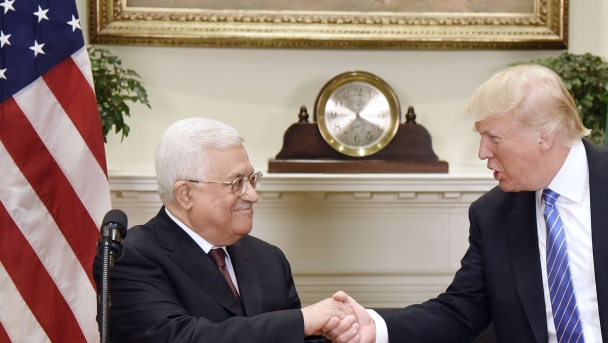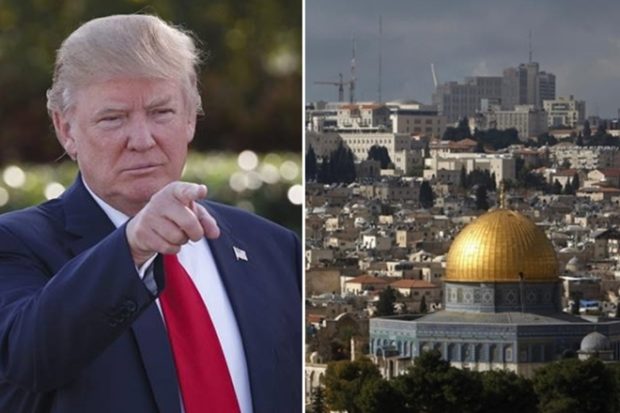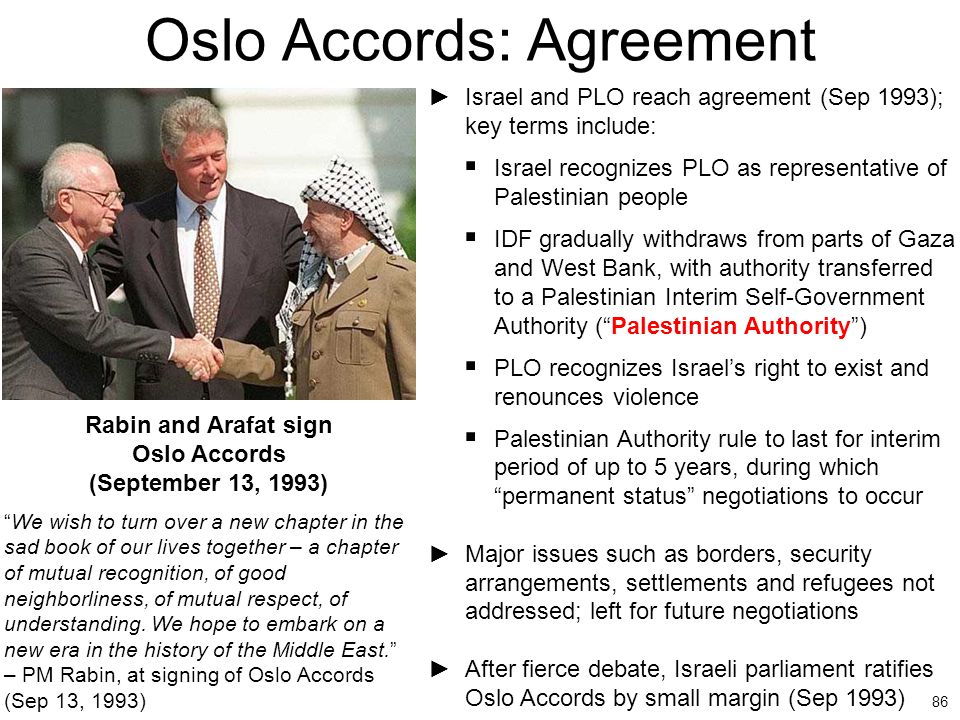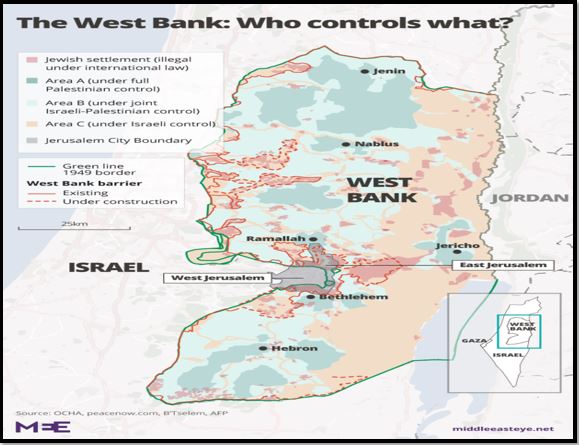
Donald Trump’s “Deal of the century” is the final phase of the 1993 Oslo Accords, which formalized the final liquidation of the Palestinian anti-colonial national struggle for independence and liberation. The “Deal” is nothing more or less than the last step of the so-called “peace process.” In order to understand the aims of the “Deal,” we need to go back to the Oslo Accords, which anticipated this step and assiduously prepared the ground for it. Since the beginning of the so-called “peace process” inaugurated in Madrid in 1991, the PLO, through its unofficial negotiators, conceded Palestinian rights one by one, in a gradual process culminating in the official PLO signing of the Declaration of Principles in Washington D.C. on September 13, 1993.
The “land for peace” formula, which the “peace” talks adopted as a point of departure, was, in fact, the first major concession of the PLO. The formula presupposes that Israel has “land” which it would be willing to give to the “Arabs,” and that the “Arabs,” seen as responsible for the state of war with Israel, can grant Israel the peace for which it has longed for decades. Placing the responsibility of the Arab/Israeli wars on the “Arabs” is a standard view that is never questioned in the West. The PLO concession, however, ensured that Palestinians and other Arabs too would not question it.
Despite its surface appearance as a political compromise, this formula was in fact a reflection of the racial views characterizing (European Jewish) Israelis and Palestinian and other Arabs. Whereas the Israelis were asked and were ostensibly presented as willing to negotiate about property, the recognized Western bourgeois right par excellence, Palestinians and other Arabs were asked to give up violence, or more precisely “their” violent means, which is an illegitimate unrecognized right attributable only to uncivilized barbarians. The fact that the PLO had already given up the Palestinian rightful claim to seventy-seven percent of Palestine and was negotiating about the future status of a mere twenty-three percent Palestine did not qualify for a formula of “land for land” on which to base the “peace process.” In reality, and from a Palestinian standpoint, the formula of “land for peace” was accurate if one reversed its interpretation, wherein it was the PLO who was giving up Palestinian rights to the Palestinians’ historic homeland in exchange for an end to Israeli oppression of and violence against the Palestinian people. (1)
The PLO, Israel, and the Western media hailed the September 13 agreement between Yasser Arafat and Yitzhak Rabin as “mutual recognition.” This construal, however, contradicts the actual words uttered by both parties, and the projected actions based on these words. Whereas the PLO (who wrote the first letter) recognized “the right of the state of Israel to exist in peace and security,”(2) the Israeli government, “in response” to Arafat’s letter, “has decided to recognize the PLO as the representative of the Palestinian people and commence negotiations with the PLO within the Middle East peace process.” This is hardly mutual recognition. For this to be mutual recognition, either the Israelis would have had to recognize the Palestinian people’s right to exist in a state of their own in peace and security, or the PLO would have had only to recognize the Rabin government as the representative of the Israeli people, without necessarily granting any “right” to the Israeli state to exist in peace and security, or in any other way.
The actual agreement, therefore, did not amount to a mutual recognition, rather, it amounted to the final legitimation of the Jewish state as having the “right” to be a racist apartheid state by the very people against whom its racist policies have been/are practiced, with the Israelis committing to nothing substantively new. Giving the PLO the recognition as the representative of the Palestinians, something the majority of the world (except the United States) has recognized since the mid seventies, committed Israel to no concessions to the Palestinian people. It committed it only to a scenario whereby since the Israeli government was inclined to speak to “representatives” of the Palestinians in the context of the “Middle East Peace Process,” it would talk to the PLO, as it finally recognized that party as their representative, whereas before it did not.
 |
| [Getty] |
The Israeli recognition of the PLO as the representative of the Palestinian people took place at the exact moment that the PLO ceased to represent the national will of the majority of Palestinians. As Israeli Foreign Minister Peres himself asserted correctly at the time, “We haven’t changed -- it [the PLO] changed.”(3) However, if the PLO stood for Palestinian national aspirations, which included the uncompromising demand for national self-determination through the establishment of a Palestinian State, the repatriation and/or monetary compensation of Diaspora Palestinians, and an end to Israeli apartheid under whose yoke Israeli Palestinians live, and as such was recognized by the Israeli government, such a recognition would surely have been a veritable concession by the intransigent Israelis. This, however, was far from what happened.
The Oslo agreement had no place for diaspora Palestinians (except, according to Rabin, for a few thousand people)(4), or for Israeli Palestinians, and, had no provisions for Palestinian national self-determination, or the establishment of a Palestinian state. Since the Arafat leadership had abandoned all the major national aspirations that the PLO embodied, the Israeli recognition of the organization was not a concession at all; rather, it was a triumph for the Israeli colonial-settler project, which had always sought to negotiate with people and governments who did not actually represent the indigenous Palestinians. The Israeli recognition of the PLO, therefore, did not depart from the Israeli strategy, which successive Israeli governments have followed diligently, of liquidating the Palestinian national struggle.
The establishment of the Israeli settler-colony resulted in the usurpation of all of historic Palestine and, in the process, the physical separation of the Palestinian people into three major segments in relation to Palestine --Palestinians citizens of Israel, Palestinians in the Occupied Territories, in the West Bank and the Gaza Strip, and Palestinians in the diaspora. The agreement was engineered by definition not to redress the injustices inflicted on the Palestinian people as such, rather, of transforming the Israeli occupation over parts of the Occupied Territories into something with which both the PLO leadership and the Israelis, more generally, could live. This would be followed later by the complete separation of Gaza from the West Bank and the severance of East Jerusalem completely.
Whereas, since the Israeli occupation and subsequent annexation of the Palestinian city of East Jerusalem, Palestinians living in that city were accorded a different legal and political status by the Israelis, the Oslo agreement separated those Palestinians who live in Gaza from the West Bank, and then subdivided Palestinians in the West Bank into Areas A, B, and C, dotted by hundreds of Israeli checkpoints.
Much of PLO and later Palestinian Authority (PA) flexibility in surrendering the rights of the Palestinian people was connected to the question of funding. The story of the Palestinian national movement can only be told through the ways and means that different Arab and non-Arab governments have tried to control it. While the PLO was established in 1964 and controlled principally by the Arab League of States within which the regime of Jamal Abd al-Nasir was hegemonic, the 1967 defeat weakened that arrangement leading to the revolutionary guerrillas takeover of the organization in 1968-69. With Fatah and the leftist Palestinian guerrillas at the helm, the revolutionary potential of the PLO constituted such a threat that it precipitated an all-out war in Jordan in 1970, a situation that powerful and repressive Arab regimes did not want to see repeated. It is in this context that Arab oil money (from Saudi Arabia, Kuwait, Libya, the United Arab Emirates and Iraq) began to pour into the coffers of the PLO, primarily to ensure that it would not encourage revolutionary change in Arab countries and that insofar as it did not compromise Arab regime interests its weapons should only be directed towards Israel. The Lebanese civil war and the PLO role in it in the second half of the 1970s remained a problem but, as far as they were concerned, it was a problem that Arab regimes were able to contain.
With the onset of the 1980s and the military defeat of the PLO in 1982 in Beirut, Arab funding for the PLO was no longer conditioned on its not turning its weapons against them only, but that the organization would also no longer target Israel. The various attempts at agreements between the PLO and King Hussein in the mid-1980s were part of that plan. With continued Israeli and US refusal to deal with the PLO no matter how much its policy and ideology had changed, the situation remained frozen until the first Palestinian uprising in 1987 gave the PLO the opportunity to lay down its weapons against Israel. The formalization of this transformation took place in Algiers in 1988 and later at the Madrid peace conference in 1991.
As oil funding dried up after the Gulf War of 1990-91, as did diplomatic support with the collapse of the Soviet Union and the Eastern Block, the PLO needed new funders. Enter the United States and its allies whose terms did not only include the Oslo agreement but also that the newly created and Fatah-controlled PA be indeed armed but that its weapons should have a new target: the Palestinian people themselves and their anti-colonial resistance. The PA obliged and continued to receive its funding until the second intifada when, contra their raison d’être, some of its security forces engaged the Israelis in gunfire when the Israelis attacked Palestinians. Funding was intermittently stopped, Arafat was placed under house arrest and the Israelis reinvaded the West Bank. A resumption of steady funding continued after Arafat’s death conditional upon Mahmoud Abbas’s “seriousness” in pointing Palestinian guns at the Palestinians themselves, which he and the PA’s thuggish security apparatuses have done.(5) Since then, PA security coordination with the Israeli occupation army became, even in the view of the PA’s unelected President Mahmud Abbas, “sacred” and untouchable.
In the meantime, while the PA had forsaken the rights of Palestinian citizens of Israel to equal citizenship when it recognized Israel, despite Israel’s dozens of discriminatory racist laws, the question of the Palestinian diaspora continued to plague its diplomacy. Yasser Arafat obliged in a now infamous op-ed for the New York Times in 2002 in which he surrendered the Palestinian right of return. Arafat frankly expressed his "understanding" and "respect" of the Israeli need to maintain Jewish demographic supremacy. He asserted that: “We understand Israel's demographic concerns (6) and understand that the right of return of Palestinian refugees, a right guaranteed under international law and United Nations Resolution 194, must be implemented in a way that takes into account such concerns.
Arafat proceeded to state that he was looking to negotiate with Israel on "creative solutions to the plight of the refugees while respecting Israel's demographic concerns," that is, "respecting" its Jewish supremacist demographic concerns. Arafat's position was reiterated by his US-picked successor Mahmoud Abbas, who conceded his own right to return to the city of Safad, now in Israel, from which he and his family had been expelled in 1948. Ten years after Arafat's concession, Abbas declared on Israeli television in November 2012: “Palestine now for me is '67 borders, with East Jerusalem as its capital. This is now and forever... This is Palestine for me. I am a refugee, but I am living in Ramallah. I believe that the West Bank and Gaza is Palestine and the other parts are Israel.”(7)
Now that Israel’s right to be a racist state was guaranteed by the Palestinian leadership, wherein its racist demographic concerns would not longer be threatened either by the demand for equality for Palestinian citizens or by the return of the Palestinian refugees it expelled, attention was focused on East Jerusalem and West Bank colonization, as precursors to the final liquidation of the Palestinian national struggle.
 |
| [Getty] |
The failure of the Camp David talks in the summer of 2000, which resulted in Yasser Arafat's rejection of Ehud Barak's final offer (which is the likely basis of Trump’s “Deal,” although the latter promises to be less “generous”), made it clear what the Oslo Accords had in store for the Palestinians. In the language of Israeli and Western propaganda, Barak offered Arafat 73% of the West Bank, which could expand in 10 to 25 years to 91% (although some American and Israeli accounts insisted that Barak offered 95% of the West Bank).
The West Bank, however, means something different for the Israelis from what it means to the Palestinians and international law. The West Bank was the name the Jordanian authorities gave to the Central and Eastern parts of Palestine that they annexed in 1950. This included the small city of East Jerusalem, which was six square kilometers in size when the Israelis occupied it in 1967. Israel however redefined the West Bank as not only to exclude the small city of East Jerusalem but, in fact, also to exclude the much-expanded city which the Israelis annexed in 1967 and ratified their annexation in 1980 by expanding its size to 70 square kilometers at the expense of West Bank lands, i.e. they expanded it to almost 12 times its original size. United Jerusalem would be renamed in the 1980s by the Israelis as "Greater Jerusalem", and it would be expanded to almost 300 square kilometers by stealing more land from the West Bank.
Indeed Greater Jerusalem has come to encompass almost 10 per cent of the West Bank, not to speak of the more recent plan of Metropolitan Jerusalem, whose geographic size is being expanded by the Israelis to encompass possibly as much as 25% or more of West Bank lands. It is this “United Jerusalem” as the eternal capital of Israel that is not part of the negotiations. Talk of renaming the adjacent village of Abu Dis as the new East Jerusalem to satisfy the PA was productive if inconclusive over the last two decades. Trump has formalized the question of Abu Dis as the only possible PA capital in the future.(8) Trump’s move of the US embassy from Tel Aviv to Jerusalem was meant to remove any hope for the reopening of negotiations on this question.
Even the question of the colonial-settlements was settled through preliminary arrangements that all the big blocks of settlements would be annexed to Israel in exchange for some land that Israel might cede to the PA. With all these issues being part of talks and discussions, there were never any commitments to a Palestinian State by the Israelis or the Americans, even when the Americans would speak of a two-state solution, as all indications were that if a PA mini-state were established, it would have no army, and no sovereignty over water or borders, and no sovereignty over Jewish settlements. Essentially, what was being offered was exactly what the PA was able to obtain after Oslo –namely a Palestinian administrative staff to manage the population and a Palestinian coercive force to assist the Israeli army in repressing the Palestinian people’s resistance to Israeli occupation.
 |
| [Middle East Eye] |
The cessation of the peace process under Benjamin Netanyahu since 2014 is fully in keeping with the Oslo Accords. As explained earlier, the Accords only stipulated that Israel recognized the PLO as the sole legitimate representative of the Palestinian people, and that if Israel were to negotiate with representatives of the Palestinians in the context of “the Middle East peace process,” it would negotiate with the PLO. However, Israel did not commit to open-ended negotiations or to concluding a peace agreement with the PLO, especially in the absence of a “peace process.” Indeed, even Trump’s recent closure of the offices of the PLO mission in Washington DC (which PA propagandists mislabel as the “Palestinian embassy”), is in keeping with the Oslo agreements and with US policy before and after Oslo. After all, Arafat had become persona non grata in the US following his refusal to sign an agreement at Camp David in 2000, just like the PA Mission had become more recently.
It is in this context that the US moved in the last few months to dismantle UNRWA and the very legal category of “refugee” as applied to Palestinian refugees, moved its embassy to Jerusalem, withdrew its commitment to a two-state solution, hatched a plan with the aid of the Egyptian government for a permanent resolution to Gaza’s humanitarian crisis, raised no objections to continued colonial settlement in the West Bank, and issued no official objections to Israel’s nation-state law, enacted in July of 2018. (9) The enactment of Israel’s nation-state law demonstrates Israel’s abandonment of its prior propagandistic commitment to being a “Jewish and democratic” State, in anticipation of maintaining its illegal and racist rule over the indigenous Palestinian population in all of historic Palestine, and not only in Israel’s 1948-49 borders, a population who, despite Israel’s ongoing expulsions since 1948, had come again to outnumber the Jewish colonists and their descendants in Israel and the Occupied Territories. Here, the law’s reference to the “land of Israel” rather than to the State of Israel, as the “homeland of the Jewish people,” anticipates permanent Jewish control over the whole of historic Palestine.
It is in light of the recognition that Israel will no longer be able to change the country’s demographics easily that the law was enacted: namely, to declare Israel’s open commitment to being a “Jewish State” that is not “democratic,” and dispensing with the trappings of its erstwhile propaganda of a so called “Jewish and democratic State.”
In this light, the culmination of the Oslo Accords in “the Deal of the Century,” as the final stage of the Accords, has ensured two outcomes that will continue to secure Israel’s colonial settler project and its racialized Jewish State, namely the collaboration of the Palestinian business class with its colonial project, a collaboration at which Palestinian businessmen have excelled since 1993 and from which they have reaped and continue to reap the requisite profits, and the collaboration of the erstwhile Palestinian guerillas-turn-mercenaries for the Israeli army in enforcing the Occupation and suppressing Palestinian resistance to it. It is these two key projects that will survive the Deal of the Century, alongside a permanent Israeli colonial settlement protected by racially separatist laws that ensure Jewish supremacist rights and privileges. The Oslo Accords inaugurated this process of liquidating the Palestinian national struggle, while the Deal of the Century plans and hopes to conclude it.
 |
|
"The Persistence of the Palestinian Question: Essays on Zionism and the Palestinian Question” by Joseph Massad |
(1) I reproduce here my analysis of the Oslo Accords which I published in an article in 1994 titled “Repentant Terrorists or Settler-Colonialism Revisited: The PlO-Israel Agreement in Perspective,” reproduced in Joseph A. Massad, The Persistence of the Palestinian Question: Essays on Israel and the Palestinians, (London: Routledge, 2006).
(2) For the texts of the letters of recognition between Israel and the PLO, see the New York Times, September 10, 1993, p. A 12.
(3) Quoted in the New York Times, September 10, 1993, A 12.
(4) New York Times, October 27, 1993, A 3, Rabin asserted that if the PLO “expect[s] tens of thousands [of returnees,] they live in a dream, an illusion.”
(5) See my article “How surrendering Palestinian rights became the language of ‘peace,’” Electronic Intifada, 27 January 2010. https://electronicintifada.net/content/how-surrendering-palestinian-rights-became-language-peace/8640
(6) Yasser Arafat, “The Palestinian Vision of Peace,” New York Times, 3 February 2002.
(7) “Mahmoud Abbas outrages Palestinian refugees by waiving his right to return,” The Guardian, 4 November 2012.
(8) “Talk of a Peace plan that snumbs Palestinians Roils Middle East,” New York Times, 3 December 2017.
(9) The Trump White House did however ask Israel for “clarifications” from the Israeli Prime Minister’s Office on the law’s impact on minorities and was assured that it would not impact them negatively. See “US said to have sought clarifications from Israel on nation-state law,” The Times of Israel, 1 August, 2018, https://www.timesofisrael.com/us-sought-clarifications-from-israel-on-nation-state-law-report/
